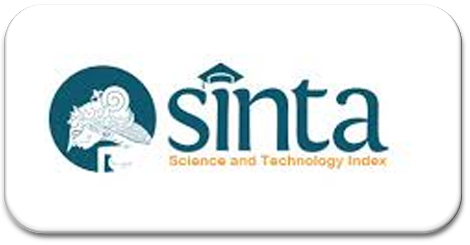INTERNET DAN PERILAKU CYBERLOAFING PADA KARYAWAN
Abstract
Keywords
Full Text:
PDFReferences
Abidin, R., Abdullah, C.S., Hasnan, N., & Bajuri, A.L. (2014).The relationship of cyberloafing behavior with big five personality traits. Australian Journal of Basic and Applied Sciences. 8(12), 61-66.
Antariksa, Y. (2012). Tiga alasan penting kenapa akses internet harus ditutup selama jam kantor. Diakses pada tanggal 24 oktober 2017, dari http://strategimanajemen.net/2012/04/23/3-alasan-kenapa-akses-internet-kudu-ditutup-selama-jam-kantor/
Asosiasi Penyelenggara Jasa Internet Indonesia (APJII) (2016). Infografis Penetrasi dan Perilaku Pengguna Internet Indonesia 2016. Jakarta: Penerbit Polling Indonesia.
Askew, K. L. (2012). The relationship between cyberloafing and task performance and anexamination of the theory of palnned behavior as a model of cyberloafing. Disertation. University of South Florida.
Bappeda. (2014). Banda Aceh Islamic Cyber City. Diakses pada tanggal 14 Desember 2017, dari https://bappeda.bandaacehkota.go.id/program-strategis/baicc/
Blanchard, A., & Henle, C. (2008). Correlates of different form sof cyberloafing : The role of norms and external locus of control. Computers in Human Behavior. 24, 1067-1084. Ded. (2010). Ganggu pelayanan, PNS dilarang Facebook-an. Di akses pada tanggal 26 oktober 2017, dari https://news.okezone. com/read/2010/01/22/337/296570/ganggu-pelayanan-pns-dilarang-facebook-an
Garrett, R. K., James N., & Danziger. (2008). “Disaffection or Expected Outcomes: Understanding Personal Internet use During Work”. Journal of Computer-Mediated Communication. 13, 937–958.
Greenfield, D. N., & Davis, R. A. (2002). Lost incyberspace: The web at work. Journal of Cyber Psychology and Behavior. 5, 347-353.
Hurlock, E. B. (1990). Psikologi Perkembangan: Suatu Pendekatan Sepanjang Rentang Kehidupan. Alih Bahasa: Soedjarwo dan Iswidayanti. Jakarta: Erlangga.
Kemp, S. (2017). Digital di asia tenggara tahun 2017. Diakses pada tanggal 7 februari 2018 dari, https://wearesocial.com/special-reports/digital-southeast-asia-2017
Lim, V. K., & Chen, D. J. (2012). Cyberloafing at workplace: gain or drain on work?. Behavior & Information Technology. 31( 4), 343-353.
Malhotra, S. (2013). Cyberloafing a holistic perspective. An Online Interdisciplinary, Multidisciplinary dan Multi-cultural Journal, 2. Diunduh 02 September 2018 dari http://www.bharatcollege.in/PDFs/cyberloafing-%E2%80%93-a-holistic-perspective.pdf
Ozler, D. E., & Polat, G. (2012). Cyberloafing phenomenon in organization: Determinants and Impact. International Journal of eBusiness and eGovernment Studies. 4(2), 1-15.
Peabody, D., L.R. Goldberg. (1989). Some determinants of factor structures from personality trait discriptors. Journal of Personality and social Psychology. 57, 552-567.
Rustandi, F. D. (2016). Pengaruh regulasi diri terhadap perilaku cyberloafing pada karyawan di Kota Bandung. No. Skripsi : 612/SKRIPSI/PSI/FIP-UPI.10.2016
Selwyn, N. (2008). “A safehaven formisbehaving?Aninvestigationofon line misbehavior among university students”. Social Science ComputerReview. 26, 446-465.
Sugiyono. (2013). Metode Penelitian Kuantitatif, Kualitatif, dan Kombinasi (Mixed Methods). Bandung: Penerbit Alfabeta. Undang-Undang Republik Indonesia Nomor 5 tahun 2014. (2014). Aparatur Sipil Negara. Di akses pada tanggal 19 Februari 2018, dari https://luk.staff.ugm.ac.id/atur/UU5-2014AparaturSipilNegara.pdf
Ugrin, J. C., Pearson, J. M., & Odom, M. D. (2007). Profiling cyber-slackers in the workplace: demographic, cultural and workplace factors. Journal of Internet Commerce. 6(3), 75-89.
Vitak, J, Crouse,J, & LaRose, R. (2011). PersonalInternet useat work: Understanding cyberslacking.Computers in Human Behavior. 27, 1751–1759
DOI: http://dx.doi.org/10.22373/psikoislamedia.v4i1.6347
Refbacks
- There are currently no refbacks.
Copyright (c) 2020 Mirza Mirza, Thaybatan AR, Harri Santoso
Published by Faculty of Psychology UIN Ar-Raniry
Journal Secretariat:
Jl. Syeikh Abdur Rauf, Fakultas Psikologi, Kopelma Darussalam UIN Ar-Raniry, Banda Aceh, 23111,
e-mail: [email protected]
INDEXED BY:

This work is licensed under a Creative Commons Attribution-ShareAlike 4.0 International License.





_(1).png)
1_(1).png)
_(1).png)








.png)